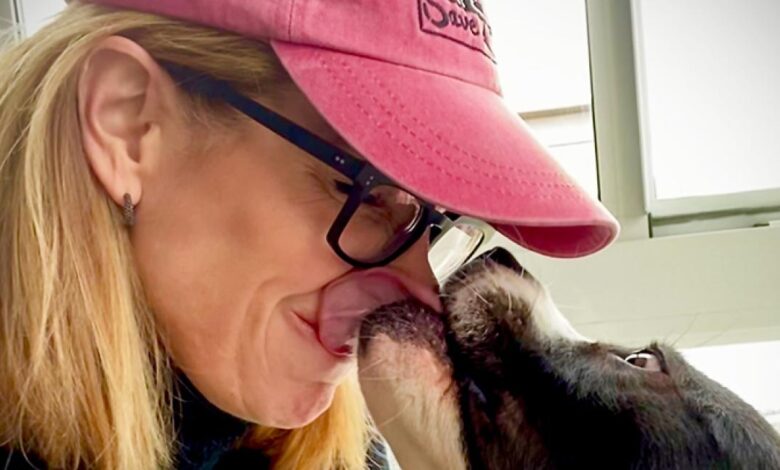
As dog owners, we all know the feeling of pure joy when our furry companions shower us with wet, slobbery kisses. But have you ever stopped to think about why dogs lick? Or what they’re trying to tell us through their licking behavior? This blog post will explore the fascinating world of dog tongues and share real-life stories about dogs and their licking habits. Get ready to laugh, learn, and fall even more in love with your canine companion as we delve into the world of dog licking stories.
Introduction to Dog Licking Stories
Dogs are known for their boundless energy, loyalty, and of course, their affectionate nature. And nothing says “I love you” quite like a big, sloppy lick from your furry best friend. But did you know that this seemingly simple gesture holds so much more meaning than we realize?
Before we dive into the world of dog licking stories, let’s take a closer look at the science behind this behavior. Why do dogs lick? Well, there are actually several reasons:
The Fascinating World of Dog Tongues
Dog tongues are truly remarkable – they are powerful, versatile, and have many unique features that set them apart from other animals. For starters, did you know that a dog’s tongue is made up of four types of papillae (small, raised bumps)? These papillae serve different functions, such as helping dogs lap up water or scrape meat off bones.
One of the most interesting things about dog tongues is their ability to sweat. Unlike humans who sweat through our skin, dogs sweat mainly through their paws and tongues. When they pant, moisture evaporates from their tongues, helping to cool them down.
But perhaps the most intriguing feature of dog tongues is their rough texture. Have you ever been on the receiving end of a dog’s lick and felt like you were being sandpapered? That’s because a dog’s tongue is covered in tiny, backward-facing barbs called filiform papillae. These barbs serve to scrape meat off bones, groom their fur, and even remove parasites from their skin.
Now that we have a better understanding of dog tongues, let’s explore some real-life stories about dogs and their licking habits.
Real Life Stories of Dogs and Their Licking Habits
Dogs are known for their quirky behaviors, and licking is no exception. But what may seem strange to us humans is perfectly normal for our canine companions. Here are a few heartwarming stories of dogs and their unique licking habits:
Story 1: The Comforting Lick
One day, my friend’s mother fell ill and had to stay in the hospital for a few days. Her loyal dog, Buddy, refused to leave her side and would sit by her bed all day. But it wasn’t until one night when she was struggling to sleep that Buddy’s true love and devotion shone through. He climbed onto her bed and gently licked her face until she fell asleep, providing her with comfort and reassurance during a difficult time. From that moment on, Buddy became known as the “little nurse” in the family.
Story 2: The Protective Lick
Another heartwarming story comes from a family whose house caught fire in the middle of the night. While everyone was safe, their dog, Max, was visibly shaken and wouldn’t stop frantically licking their faces. It wasn’t until later that they realized that Max was trying to wake them up and alert them to the danger. Thanks to his quick thinking and protective nature, everyone made it out of the house unharmed.
Story 3: The Healing Lick
Dogs are naturally drawn to those who need comfort, and that was certainly the case for one young girl who was terminally ill. Her family’s dog, Rufus, would spend hours each day lying by her side, gently licking her face and paws. Despite being in pain, the girl’s face would light up with a smile every time Rufus licked her, providing her with much-needed comfort and love during her final days.
The Science Behind Canine Licking Behavior
While these stories may seem like heartwarming acts of love, there is actually a scientific explanation behind why dogs lick.
One of the main reasons dogs lick is to show affection and form bonds with their owners. This behavior is a remnant from their wild ancestors who would lick the pack leader’s face as a sign of submission and respect. By licking us, dogs are showing that they view us as their pack leader and want to strengthen their bond with us.
Licking also serves as a form of communication for dogs. When a mother dog gives birth, she licks her puppies to clean them and stimulate their breathing. As they grow older, puppies will lick their mother’s face and mouth to beg for food. This behavior carries over to their interactions with humans, as dogs will often lick their owner’s face to show that they are hungry or want attention.
Another interesting reason why dogs lick is to gather information about their surroundings. Dogs have an amazing sense of smell, and by licking, they can gather scent particles from objects or people. This is why you may find your dog sniffing and licking new objects that come into your home – they are trying to understand what it is and where it came from.
The Different Types of Dog Lickers
Just as there are different reasons why dogs lick, there are also different types of dog lickers. Some dogs are more excessive lickers than others, and their licking behavior can vary depending on the situation.
The Affectionate Licker
These dogs love to show their love and affection through licking. They will often lick their owner’s face, hands, or feet as a way to show they care. While this behavior can be endearing, it can also become excessive if not properly trained.
The Attention-Seeking Licker
These dogs have learned that by licking, they can get their owner’s attention. They may lick when they want food, need to go outside, or just want some cuddle time. This type of licker can be easily trained to stop the behavior by redirecting their attention to something else.
The Anxious Licker
Dogs who suffer from separation anxiety or other forms of anxiety may resort to licking as a way to soothe themselves. They may also lick excessively when they are feeling stressed or uncomfortable. In these cases, it is important to address the underlying anxiety and work on calming techniques to reduce the need for excessive licking.
The Compulsive Licker
Some dogs develop a compulsive licking behavior, which can become a problem if it interferes with their daily activities. This type of licking is usually a result of boredom, anxiety, or an underlying medical condition. If your dog is exhibiting compulsive licking behavior, it is best to consult with a veterinarian to rule out any potential health issues.
How Dog Licking Can Be Harmful (Or Beneficial) for Humans
While we may love the feeling of our dog’s wet kisses, there are some instances where dog licking can actually be harmful to humans. Let’s take a look at both the potential harm and benefits of dogs licking humans:
Harmful Effects of Dog Licking
- Bacteria – Dogs’ mouths are full of bacteria, some of which can be harmful to humans. When a dog licks us, these bacteria can transfer onto our skin, potentially causing infections.
- Allergies – Some people may be allergic to proteins found in a dog’s saliva, causing them to experience skin irritation or other allergic reactions.
- Parasites – If a dog has recently eaten something contaminated or has come into contact with parasites, their lick can transfer these onto human skin.
Beneficial Effects of Dog Licking
- Healing properties – While not scientifically proven, some people believe that a dog’s saliva contains enzymes that help heal wounds. In fact, there are stories of dogs licking their owner’s injuries and seeing improved healing time.
- Boosts immunity – Some studies have shown that exposure to a dog’s saliva can boost the human immune system, making us less prone to allergies and illnesses.
- Relieves stress – There is something incredibly soothing about a dog’s warm, wet tongue. Many people find that their stress and anxiety levels decrease when their dog licks them.
It is important to weigh both the potential harm and benefits of dog licking and take precautions to minimize any risks.
Hilarious Tales of Dogs Licking the Wrong Things
As we all know, dogs don’t always have the best judgment when it comes to what they choose to lick. Here are some hilarious (and slightly gross) stories of dogs licking the wrong things:
- A dog who licked a lit candle and singed off his whiskers (don’t worry, he was okay!).
- A dog who licked a toad and ended up with a swollen, frothy mouth.
- A dog who licked a cactus and got spines stuck in his tongue (ouch!).
- A dog who licked a skunk and had to endure several baths to get rid of the smell.
- A dog who licked a slug and ended up with a mouthful of slime (gross!).
While these may just be funny anecdotes, they serve as a reminder to keep an eye on our dogs and make sure they’re not licking anything harmful or potentially dangerous.
The Evolution of Licking in Domesticated Dogs
Now that we’ve explored the various reasons why dogs lick, let’s take a step back and look at how this behavior has evolved in domesticated dogs.
In the wild, licking served several purposes for wolves and other canines. It was a way to show submission to the pack leader, solicit food from other pack members, and clean themselves and their young. As dogs became domesticated and integrated into human households, they carried over these behaviors but adapted them to fit into their new environment.
Today, dogs will often lick their owners’ faces as a way to show submission and love. They may also lick their owner’s hands or feet to beg for food, similar to how they would have done with their pack members in the wild.
What Your Dog’s Licking Can Tell You About Their Health
As we’ve discussed, dogs lick for a variety of reasons. But did you know that your dog’s licking behavior can also give you clues about their health? Here are a few things to keep an eye out for:
- Excessive licking of one particular area could indicate pain or discomfort in that area.
- Constant licking of the paws could be a sign of allergies or skin irritation.
- Changes in licking behavior, such as suddenly licking excessively or not licking at all, could signal an underlying health issue.
If you notice any changes in your dog’s licking behavior, it is best to consult with a veterinarian to rule out any potential health problems.
Conclusion: Why We Love Hearing (and Telling) Dog Licking Stories
Dogs are truly amazing creatures, and their licking behavior is just one of the many ways they show us love and communicate with us. From heartwarming stories of dogs comforting their owners to quirky tales of dogs licking the wrong things, there’s no denying that dog licking stories make us smile and remind us of the strong bond we share with our furry companions.
So the next time your dog showers you with slobbery kisses, remember that it’s not just a simple gesture – it’s their way of showing love, seeking attention, and communicating with you. And don’t forget to share your own dog licking stories with friends and family – because who doesn’t love a good story about man’s best friend?
The Ultimate Love Story How My Dog Stole My Heart
Beloved Dog Becomes Guardian Angel for One-Year-Old, Offering Working Parents Peace of Mind.5MR

















